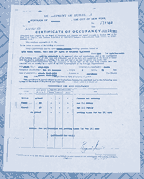- Publications:
- Newsletter:
- How-To Tutorials:
- Consumer Guides:
- Related:
Review: Masthead
Media Notice: Please read the Terms of Use for further details regarding reprint permissions.

Image by Robert Ubell
Masthead:
Publishers:
Accurate Building Inspectors ©
Division of Ubell Enterprises, Inc.
1860 Bath Avenue
Brooklyn, NY 11214
voice – [718] 265.8191
toll free voice – [800] 640.8285
fax – [718] 449.7190
Lawrence J. Ubell *
- President
Alvin Ubell **
- Founder Vice President
Matthew Barnett *
- Senior Inspector
Estelle R. Ubell
- Sec. Treasurer
Emily Hoffman
- Editor & Broadcaster, WNYC & WQXR
Contributors:
Robert H. Wolff, Esq. of Rosenberg,
Minc, Falkoff & Wolff, LLP
Ari Saltz, of GFI Mortgage Bankers, Inc.
Stanley Turkel, MHS, ISHC
Bertrum Herman, Esq.
Howard Kurtzberg, Esq.
Sebastian M. D'alessandro, RA, AIA
* Licensed in: New York - New Jersey
** Licensed in: NJ
Contribute:
If there is a subject that you would like to see discussed or an article that you would like to contribute to be featured
in The Gotham City Inspector©, please forward your comments to:
Letters to the Editor
Media Notice: The publishers, grant reprint permission of all articles in the Gotham City Inspector© Newsletter, provided that appropriate written recognition is given to the authors and “The Gotham City Inspector©”. For online reprints, please also include an HTML link to The Gotham City Inspector©: www.accuratebuilding.com

The Gotham City Inspector©
May 2005, Vol. 2, No. 4
![]() Gotham City Inspector Newsletter
Gotham City Inspector Newsletter

Spring Issue: Headlines
- • Inspector's Diary: “Watch Your Step & Hold On!”
- • The ABC's Of A “C Of O”
- • Water Worries: Don't Be “Lead” Astray
- • When Hot Water Is Too Much Of A Good Thing!
- • House Proud: Chimney Sweep
- • The Legacy Of Terry Schiavo
- • Tool Of The Month: Knipex Plier Wrench
Inspector's Diary
Watch Your Step & Hold On!

Stair-related incidents are the second most common cause of personal injuries in the United States. (Injuries from automobiles are the most common.) In this month's Inspector's Diary, we point you to our stair safety research paper on the Accurate Building Inspector's website: “Watch Your Step & Hold On!”
Attorney Corner
The ABC's Of The ‘C. Of O.’:
by Contributor Sebastian M. D'alessandro, RA

What is the difference between a “Temporary” Certificate of Occupancy and a “Final” Certificate of Occupancy? This is a common question among attorneys, building owners, managing agents, home/building inspectors and other professionals.
A “Certificate of Occupancy”, otherwise referred to as a “C. of O.” or “C.O.”, is a document issued by the NYC Buildings Department that describes a buildings' legal use and occupancy. It also describes the “meets and bounds” of the property on which the building is located.
Title 26 of the New York Administration Code states that it shall be unlawful to occupy or use any building unless and until a C. of O. is issued by the Commissioner, certifying that such building has been inspected and conforms to the approved plans and applicable building codes. This applies to any new building as well as any building that has undergone a renovation.
There are various required inspections and sign-offs by the inspecting architect or engineer, which need to be obtained prior to the issuance of a “Final” C. of O. The most common items are: construction, plumbing and electrical; and possibly sprinkler, elevator, fire alarm, sidewalks, tree planting, or other specialty items applicable to the specific building. A licensed engineer or a registered architect must submit inspection affidavits, known as “controlled inspections”, attesting that he or she witnessed the specific required items during the course of construction; such as the placement of fire stops, the use of high strength bolts, inspection of welds, concrete test, shoring, etc.
There are times, however, when the Buildings Department will issue a “Temporary” Certificate of Occupancy, also known as a T.C.O., on a building prior to the completion of all of the required items. This only occurs under unusual circumstances, such as a high rise office building with multiple tenants, enabling some of the tenants to move in when remaining portions of the building have not been completely finished. However, all of the life and safety features must be in place and inspected, as well as sign-offs on construction, plumbing and elevator, before a “Temporary” will be released. The Buildings Department may allow the electrical or other non-life safety inspections, such as tree planting, to be “open” upon the release of the “Temporary” Certificate of Occupancy.
When a Temporary Certificate of Occupancy is issued, it usually expires within ninety (90) days, from the date of issuance and may then be renewed for an additional ninety (90) days. Typically, the Buildings Department will grant three (3), renewals before the applicant must respond as to why not all of the “open” required items have been resolved. If the “Temporary” Certificate of Occupancy is allowed to lapse past the specified expiration date, it then becomes “null and void” and occupancy of the building should cease until a new “renewal” or “final” Certificate of Occupancy is obtained. Continued occupancy after the expiration date specified on the T.C.O. can lead to violations being issued by the Buildings Department as well as placing the building owner in a vulnerable liability exposure should an “incident” occur.
A construction project may be physically complete, but it is not “fully” complete until a “Final” Certificate of Occupancy has been issued.
Caveat Emptor: Buyers & Owners Beware. There are a few developers, builders and contractors that will use the T.C.O. as proof that the construction project is substantially completed, to obtain final payment from a buyer, owner or a financial or lending institution. If it is the final payment, you may find that you or your client has been deceived. You may find that the paper work for the Buildings Department - in order for them to issue a final C. of O.- has not been completed and much of the construction work was improper and/or incomplete. If you don't have the final C. of O. at closing or at the time of final payment, your ability to obtain the C. of O. could be very costly.
But watch out! Some developers will have a clause in the contract, stating, “when a T.C.O. is issued, it will constitute that the project is complete”, final payment or closing is then demanded.
Sebastian M. D'Alessandro, is a registered architect licensed in the State of New York. He is the founder and principal of D'Alessandro & Associates located in Brooklyn, NY with over twenty years of experience, providing architectural, zoning and building services to owners, managers, attorneys, contractors, engineers, architects and others. Mr. D'Alessandro is also a member and the Treasurer of the Brooklyn Chapter of the American Institute of Architects.
Living In New York
Water Worries: Don't Be “Lead” Astray
In past issues, we talked about the dangers, especially to children, of lead in paint. They lick the paint on the walls or the lead dust on the floor from peeling or cracked paint. But that's not the only hidden hazard of lead. It can get into the drinking water through old pipes, joints or faucets and is just as toxic when it is injested that way. Under the current law, when the tap water in one apartment is found to be contaminated, only the tenant who requested the lead test is notified. Other tenants are still in danger but left uninformed.
A new bill proposed by Councilman Peter Vallone, Jr., if passed, will change that. It will require building owners to be notified of the results of the tests and then, to post the results for all to see.
Officials say that the city's water supply arrives from the upstate reservoirs “lead-free,” but that it is contaminated because of aging pipes and fixtures. Newer plumbing does not contain lead that for years was used in construction.
The Department of Environmental Protection has offered free water testing kits to all city residents since 1993. You can call the City at 311 to request a kit.
If the water test shows that your drinking water contains lead above 15 parts per billion, you should take the following precautions:
- Run the tap: Anytime the faucet has been unused for more than five hours, let the water run for at least 15 to 30 seconds before drinking or using it for cooking.
- Use cold water for cooking: Hot water dissolves lead more quickly than cold water. If you need hot water, it's better to heat up cold water on the stove. Check your plumbing: Get rid of loose lead solder and debris from the plumbing by removing the faucet strainers from all taps and running the water for 3 to 5 minutes. Also, notify the City if your copper pipes are joined with lead solder (which has been banned since 1986).
- Check home wiring: If grounding wires from the electrical system are attached to your pipes, oxidation may be greater.
It's important to find out if your water is safe and to alert your neighbors. The passage of this bill would be a step in the right direction.
Consumer Safety

Water Worries: When Hot Water Is
Too Much Of A Good Thing!
View Graph: Hot Water Graph
Most of the complaints that people have about hot water is that there's not enough of it. Many city landlords are fined each year because they don't provide adequate heat and hot water. But what about the other extreme? Scalding from water that is too hot - 150 degrees or above - is a serious danger, especially for children and the elderly. Each year, 2600 people are injured by excessively hot tap water from faucets and up to 180 people die from scalding.
The primary method of producing domestic hot water in multiple dwellings is via internal coils in boilers. Most of these are pressure steam boilers that have an inside temperature that could reach 230 degrees. The water heated by the internal coil can be 200 degrees. It could come out of the faucet boiling!
The major problem with domestic hot water is not that landlords want to deliver scalding water, but that there is a lack of proper technology to prevent it. What can be done? A device called a Hoby Valve adjusts and mixes cold and hot water to the right temperature. It is expensive to buy and install which is why most landlords don't use it. If they did, most scalding cases would not exist.
Unfortunately, there is no enforcement for not using mixing valves. City laws indicate a required minimum water temperature - 140 degrees - but not a maximum temperature, except in hospitals. The law says property owners must maintain buildings in an acceptable standard, not an optimum one.
We believe 150 degrees should be the maximum home water temperature. It is more than adequate to clean clothes, dishes and for other household needs. Remember: a typical “hot” shower is approximately 105 degrees. Any hotter and you'll be jumping out of the shower, especially if someone flushes a toilet in the apartment above. That causes a drop in cold water pressure and a jump in water temperature of up to 20 degrees.
Another level of protection is a single lever mixing valve at all bathtubs and showers. With these temperature control devices, it is impossible to shut cold water off entirely. Hotels use them. Homes should as well.
House Proud
Chimney Sweep!
Most buildings have at least one chimney. Even if there's no fireplace, the heating appliances that burn gas, oil, wood or coal often rely on a chimney to carry toxic gases outside. So fireplace or not, now is the perfect time to add “sweep the chimneyrdquo; to your list of Spring cleaning chores, especially since some companies offer off-season discounts.
A dirty chimney is a dangerous chimney. According to the United States Consumer Product Safety Commission, last year there were more than 18,000 residential fires in the U.S. that started in chimneys and fireplaces. Prevent trouble by checking them once every two years.
It can take as little as two hours and as long as several days to clean a chimney. The price can range from $79 to $225. Higher-priced sweepers spend more time on cleaning the chimney and laying down plastic to protect your house from soot.
Chimneys can be damaged by rain, fireplace fires and birds. Birds like to perch at the chimney top because it's warm but are often overcome by carbon monoxide fumes and fall in. A blocked chimney is dangerous to you if the smoke and carbon monoxide fumes don't vent properly.
Cleaning a chimney can be as simple as brushing the chimney flue or as messy as opening a wall, replacing dampers and lining the flue with stainless steel. It's best to hire a professional chimney sweep. And no. Dick van Dyke is no longer in the business.
Consumer Awareness
The Legacy of Terry Schiavo
The Importance of Living Wills
Terri Schiavo didn't have a living will. But because of her, thousands of other Americans won't make that same mistake.
The Gotham City Inspector believes that drafting a living will is a fundamental responsibility that should not be ignored. Here are some tips for getting it done:
- Consult your attorney. As part of your estate planning, an attorney should be able to draft a living will along with a last will and testament and a power of attorney selection.
- For “do it yourselfers,” one of the best templates for writing a living will is called Five Wishes, which was created by Aging With Dignity (online at www.AgingwWithDignity.org), a nonprofit group based in Tallahassee, Fla., that provides information and tools to draft health directives.
- Keep track of your living will. The U.S. Living Will Registry will store an electronic version of your health-care directive and provide copies as needed, 24 hours a day, to health-care providers anywhere in the country.
Links: www.UsLivingWillRegistry.com
www.MyHealthDirective.com has joined forces with Aging With Dignity to provide electronic storage of individuals' versions of Five Wishes.
Take control of your life. Get a living will!!
Tool Of The Month
Knipex Plier Wrench

When it comes to something as basic as a hand tool, you wouldn't think there would be much room for improvement. But the new hybrid plier wrench from Knipex is clearly a next generation tool that improves on the original concept. It is a self-locking, cam-actuated tool that seizes upon a nut firmly and releases easily. The patented system is adjustable with one hand and does not damage chrome-plated and soft fixtures. It comes in five sizes so it can meet your many needs. Bravo to Knipex for coming up with this 21st century innovation.
“Helpful ideas at your finger tips!”
If you would like to receive the The Gotham City Inspector© newsletter, please email your request and include your name, business name, business telephone and address. E-mail: [email protected]
Copyright Ubell Enterprises, Inc. 2005 ©





